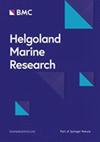Variation characteristics of ocean sediment Fe levels and their relationship with grain sizes in culture areas over a long period
4区 地球科学
Q2 Agricultural and Biological Sciences
引用次数: 0
Abstract
Iron (Fe) is an essential component for marine ecosystems, and it is related to the growth of phytoplankton communities and environmental evolution in coastal area. However, the effect of aquaculture activities on sediment Fe levels is not well studied. Fe levels and grain sizes are determined in two cores (respectively Core C in the culture area and Core A in the control area) in Sishili Bay to reveal the influence of cultivation on sediment Fe levels over an extended period. The sediment Fe levels are distinguished in the upper sections (culture period) but equal in the lower sections (non-culture period) of the two cores. The core C has the same Fe levels as Core A before 1950s (non-culture period). However, the sediment Fe levels of Core C increased during 1950s–1970s (the algae culture period) and decreased after the 1970s (shellfish culture period) compared with Core A, indicating the algae and shellfish culture impose opposite effects on sediment Fe levels. Similarly, sediment grain sizes are observed to be finer during the algae culture period but coarser during the shellfish culture period, and the variation of sediment grain sizes because of culture activities is the important factor affecting sediment Fe levels. The slowing down of ocean current due to algae culture causes finer particles and higher Fe levels in sediment. However, during the shellfish culture period, bio-deposition and re-suspension play major roles in coarsening sediment particles and decreasing sediment Fe levels.长期养殖区海洋沉积物铁含量变化特征及其与粒度的关系
铁(Fe)是海洋生态系统的重要组成部分,它与沿海地区浮游植物群落的生长和环境演变有关。然而,水产养殖活动对沉积物铁含量的影响尚未得到很好的研究。通过测定四十里湾两个岩芯(分别为培养区C岩芯和对照区A岩芯)的铁含量和粒度,揭示长期耕作对沉积物铁含量的影响。两个岩心上部剖面(培养期)沉积物铁含量不同,下部剖面(非培养期)沉积物铁含量相同。核心C的铁含量与核心A在20世纪50年代(非文化时期)之前相同。与A岩心相比,C岩心沉积物铁含量在50 ~ 70年代(藻类培养期)呈上升趋势,70年代以后(贝类培养期)呈下降趋势,说明藻类和贝类对沉积物铁含量的影响相反。同样,藻类养殖期间沉积物粒度更细,贝类养殖期间沉积物粒度更粗,养殖活动引起的沉积物粒度变化是影响沉积物铁含量的重要因素。海藻培养导致的洋流减缓导致沉积物中的颗粒更细,铁含量更高。然而,在贝类养殖期间,生物沉积和再悬浮对沉积物颗粒的粗化和沉积物铁水平的降低起主要作用。
本文章由计算机程序翻译,如有差异,请以英文原文为准。
求助全文
约1分钟内获得全文
求助全文
来源期刊

Helgoland Marine Research
地学-海洋学
自引率
0.00%
发文量
0
审稿时长
6-12 weeks
期刊介绍:
Helgoland Marine Research is an open access, peer reviewed journal, publishing original research as well as reviews on all aspects of marine and brackish water ecosystems, with a focus on how organisms survive in, and interact with, their environment.
The aim of Helgoland Marine Research is to publish work with a regional focus, but with clear global implications, or vice versa; research with global emphasis and regional ramifications. We are particularly interested in contributions that further our general understanding of how marine ecosystems work, and that concentrate on species’ interactions.
 求助内容:
求助内容: 应助结果提醒方式:
应助结果提醒方式:


